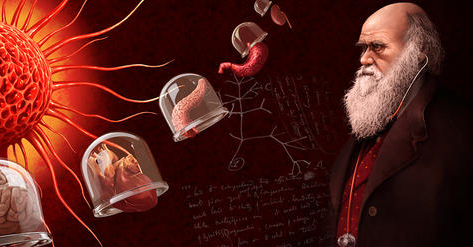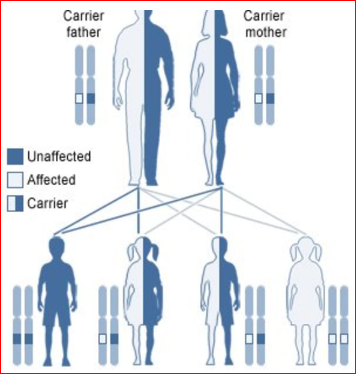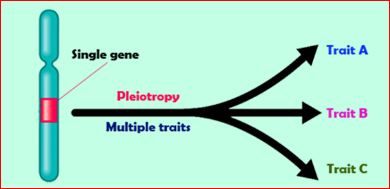The Implementation of Evolutionary Concepts in Medical Research
Yathushaa Navinan • 2024-07-05
Evolutionary medicine examines why diseases exist by looking at human evolution. This field offers explanations for various health issues and suggests strategies for treatment and prevention. Let's explore how understanding our evolutionary past can improve our health in the present.
Evolutionary medicine, also known as Darwinian medicine, is the combination of evolutionary biology, including concepts such as natural selection and survival of the fittest, and human medicine. This is useful as hypotheses and theories for why certain diseases exist can be formulated, therefore improving understanding of human disease and enabling development of more efficient treatments. Despite the potential of evolutionary medicine, it has yet to be integrated in the curriculum of medical schools. This potential can be demonstrated by the already existing evolutionary hypotheses for human diseases: heterozygous advantage, adaptation to ancestral environment and antagonistic pleiotropy.
Heterozygous advantage
This is one of the most common evolutionary explanations for disease, referring to the phenomenon where being a carrier of a disease is actually advantageous for an individual due to being heterozygous (having one dominant allele and one recessive allele), whereas individuals who inherit two of the disadvantageous alleles and are thus homozygous, end up inheriting the disease [1].
A classic example of this is sickle cell anemia, where individuals who are heterozygous for the HbAS allele had improved immunity to several malarial infections due to enhanced phagocytosis of infected red blood cells containing malaria parasites [1]. However, those who end up homozygous for the allele contract sickle cell disease [1]. Despite this severe disadvantage to individuals who are homozygous for the HbAS allele, natural selection has favoured maintenance of the allele in areas of Africa where malaria is more prominent, as “carriers of the sickle cell train enjoy a greater than 90% protection against severe malaria” [1]. Similar examples to sickle cell anaemia include other human blood diseases that have evolved as adaptations against malarial infections such as haemoglobin C and haemoglobin E disease, alpha-thalassemia and glucose-6-phosphate dehydrogenase deficiency [1].
Other diseases that can be explained by this postulation include cystic fibrosis and phenylketonuria [1].
Adaptation to ancestral environment
‘Evolutionary mismatches’ are hypothesized to be the cause of many modern-day diseases. This explanation refers to diseases that result from “the inability of our biology to keep pace with cultural change” [2]. To explain this further, our physical and cultural environments changed much faster than evolutionary processes such as natural selection could alter our allele frequency, and as a result our bodies are still adapted to ancestral environments e.g. the African Savannah [1].
Numerous diseases arise because of this mismatch between genes and the environment, for example, C282Y is a common gene mutation observed in those with hemochromatosis, and is postulated to have occurred due to our ancestors switching from a Paleolithic hunter-gatherer diet that was rich in red meat (and therefore iron) to a Neolithic cereal grain diet that occurred due to the founding of agriculture [1]. This caused the C282Y mutation to be more beneficial for our Neolithic ancestors as it provided a fitness advantage by resulting in greater iron stores, however the mutation manifested as a disease in modern society once our nutritional intake improved and caused individuals with C282Y to have excess iron stores that prove detrimental [1].
This explanation can be used to explain diseases such as addictions, which is due to exposure to substances rarely encountered by our ancestors and consequently hijack our reward systems that evolved for other purposes, as well as obesity and cardiovascular health, a result of changed to modern diets and energy budgets we have not adapted to yet [2]. Furthermore, autoimmune diseases, asthma and allergies, are based on inappropriate reactions to the loss of ancestral microbiota [2].
Antagonistic pleiotropy Several researchers have hypothesized that human beings evolved mechanisms that are beneficial in early life but prove disadvantageous by reducing their own chances of survival in later life [3]. A major example is the antagonistic pleiotropy theory of aging, which theorizes that “mutations that produce deleterious effects late in life could be positively selected during evolution, provided that they act sufficiently beneficially in the first part of life” [3]. A specific example would be alleles increasing reproductive success even though it results in accelerated aging after the reproductive period has passed [1].
In particular with aging, cellular senescence is a mechanism that is most often focused on when researching the antagonistic pleiotropy theory of aging and refers to the limited capacity of somatic cells (cells other than gametes, pathogens and stem cells) to divide by mitosis [3]. This can have deleterious effects on the individual as this mechanism impairs the regenerative capacity of damaged tissues and therefore accelerates aging [3].
Implications for treatment
Evolutionary medicine has a huge potential to improve public health and enhance health promotion as it can explain why humans engage in risky behaviour which compromises their health and safety [4]. Researchers suggest this is due to competition between the three evolutionary goals: growth, reproduction and the ability to survive, but since our bodies can’t achieve all these goals to the same extent at the same time, we experience health trade-offs [4]. For example, young men may engage in unsafe sex, such as not using a condom, as they are unconsciously prioritizing reproduction over the risk of HIV infection, and this is more likely to occur in environments where mortality risks are especially high [4]. Instances such as this provide new ideas for implementing health policies, such as providing everyone with education and job opportunities and ending insecurity, discrimination and crime to prevent conflict between evolutionary goals [4].
There are also prospects of overcoming human resistance to public health measures using evolutionary explanations [5]. Humans often knowingly engage in harmful activities such as overeating, driving fast, smoking and fighting, with a more recent example shown through how a significant proportion of humanity reduced to take the COVID-19 vaccine despite knowledge from advice from healthcare institutions that the vaccine is good for us [5]. However, such behaviour may arise due to cultural reasons as well as many public health measures providing only a small and negligible effect to many individuals [5]. As an example, many young people are reluctant to take vaccines for diseases that primarily affect older people [5]. These dilemmas are often difficult to solve by enforcing public health measures by law, as this will be considered a breach of human rights and is often impractical and costly [5]. Therefore, it is more effective for governments to use behavioural ecological approaches by increasing positive incentives for those who comply with public health measures, and negative incentives e.g. not allowing unvaccinated people into certain areas, for those who dissent [5].
Comparative medicine, a subsection of evolutionary medicine, focuses on comparing mechanisms in humans and other species to develop treatments using the knowledge of advantageous biological mechanisms other species have [2]. For instance, Peto’s paradox questions how whales and elephants are possible, assuming the fact that blue whales have 1000 times more cells than humans, and elephants have 100 times more [2]. Considering both species would have similar mutation rates per cell divisions and therefore comparably more cancer, most would have died before reproducing, and both species would not have evolved such a large body size [2]. This suggests that large, long-lived organisms have evolved mechanisms to reduce cancer risk, and possibilities for such mechanisms include lowering somatic mutation rates, greater redundancy of tumour suppressor genes, evolving cells more sensitive to triggering cell death when DNA damage is detected and eliminating proto-oncogenes [2]. Furthermore, larger organisms have lower metabolic rates, so they generate fewer oxidative species and therefore experience less DNA damage per cell cycle compared to smaller organisms [2]. However, further research acquiring evidence supporting these hypotheses is required before this knowledge can be implemented into medical research and prevention of cancer in humans.
One of the most useful applications of evolutionary biology in medical research has been antibiotic resistance and pathogen virulence [1]. It has now become obvious that bacteria rapidly evolve resistance to antibiotics, and therefore it is necessary to limit prescription of antibiotics in family medicine [1]. Evolutionary medicine has been used to develop alternatives to combat antibiotic resistance such as the development of phage therapy, which involves lytic bacteriophages (viruses that infect and kill bacteria), as agents to combat bacterial infections [5]. The process involves a lytic phage attaching to receptors on the cell surface of the bacterium, inject its viral RNA into the bacterium, undergoing viral replication using the host cell’s machinery then once new phage particles have formed, escaping the cell through lysis of the host cell bacterium [5]. It is therefore evident that more researchers should consider implementing evolutionary biology and ecology into medical research to develop new treatments for human disease and come up with policies for disease prevention.
References:
[1] https://www.ncbi.nlm.nih.gov/pmc/articles/PMC2553465/#:~:text=Evolutionary%20medicine%20deals%20with%20the,cursory%20knowledge%20of%20this%20topic
Naugler CT. Evolutionary medicine: update on the relevance to family practice. Can Fam Physician. 2008 Sep;54(9):1265-9. PMID: 18791103; PMCID: PMC2553465.
[2] https://royalsocietypublishing.org/doi/full/10.1098/rspb.2012.1326
Stearns Stephen C. 2012. Evolutionary medicine: its scope, interest and potential. Proc. R. Soc. B.2794305–4321
[3] https://onlinelibrary.wiley.com/doi/full/10.1111/j.1474-9726.2012.00807.x
Giaimo, S. and d’Adda di Fagagna, F., 2012. Is cellular senescence an example of antagonistic pleiotropy?. Aging cell, 11(3), pp.378-383.
[4] https://www.weforum.org/agenda/2023/05/6-ways-evolutionary-medicine-can-transform-our-health/
Natterson-Horrowitz, B., & Blumstein, D. T. (2023, May 25). 6 ways evolutionary medicine can transform our health. World Economic Forum.
[5] https://www.frontiersin.org/journals/science/articles/10.3389/fsci.2023.997136/full
Natterson-Horowitz, B., Aktipis, A., Fox, M., Gluckman, P.D., Low, F.M., Mace, R., Read, A., Turner, P.E. and Blumstein, D.T., 2023. The future of evolutionary medicine: sparking innovation in biomedicine and public health. Frontiers in Science, 1, p.997136
See More Posts
Copyright © 2021 Govest, Inc. All rights reserved.




